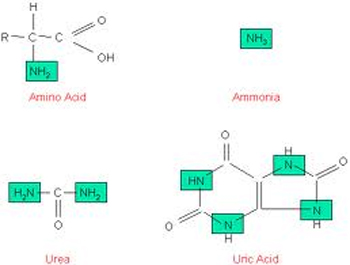Waste Products of Nitrogen Metabolism
|
|
 |
Proteins
and nucleic acids are the two main sources of nitrogenous wastes. Proteins are the source of over 95% of the
total amount of excreted nitrogen; nucleic acids make up the remaining 5%. The major problem is to get rid of the
ammonia (NH3) that forms when amino groups (–NH2) are
removed from amino acids during protein catabolism. Because ammonia is a very toxic molecule, it
is kept in low concentrations. In the
blood of vertebrates the range is 0.0001 to 0.003 mg/100 ml. Higher
concentrations can be lethal; for
example, a mouse will die if the ammonia concentration in its blood reaches 5
mg/100 ml.
Some
animals excrete nitrogenous wastes directly as ammonia, but many species
convert it to urea or uric acid immediately after it forms. These compounds are much less toxic which
permits them to be transported and stored until they can be excreted. The
animals that excrete nitrogenous wastes as ammonia need access to lots of
water; therefore, ammonia excretion is most common in aquatic species. Because ammonia molecules are small, they
easily pass through membranes and are lost by diffusion to the surrounding
water. In many invertebrates, ammonia
release occurs across the whole body surface. Teleost (bony) fishes excrete almost all of their nitrogen as ammonia
through the gills and in the urine. Excretion of most of the nitrogen as ammonia is called ammonotelic
excretion.
|
In
a third category are animals that, because of their dry habitats (or some other
reason requiring water conservation), excrete a minimal amount of urine that
contains little or no water. These
animals (e.g., land snails, insects, birds, some frogs and many reptiles)
convert ammonia to uric acid. Unlike
ammonia or urea, uric acid is insoluble in water, so only small amounts are
retained in solution–greatly limiting their toxicity. (For any substance to be toxic and achieve a
biological effect, it must be in solution.) Excretion of nitrogen in the form of uric acid is called uricotelic
excretion. Most uricotelic animals
excrete their nitrogenous waste as solid or semi-solid urine, or as uric acid
crystals.
Ammonia,
urea and uric acid are the most common nitrogenous waste products, but not the
only ones. Some sharks secrete
trimethylamine oxide (TMO). A variety of
animals also excrete small quantities of creatine and creatinine. Some animals even wastefully excrete some of
their excess amino acids.
Because
urea, uric acid and TMO are less toxic than ammonia, why don’t more animals
excrete most of their nitrogen in these forms? The answer can be explained as “biological economics”. The synthesis of these compounds is
energetically costly. Nearly half of the
food energy a terrestrial insect consumes may be used to process metabolic
wastes! In aquatic insects, ammonia
simply diffuses out of the body into the surrounding water. In general, an animal excretes its nitrogen
in a form requiring the least expenditure of energy, given the environment in
which it lives.
A
few animals excrete nitrogen that comes from the metabolism of purines (e.g.,
adenine and guanine). Purines can be
broken down to ammonia only if the animal has the specific enzymes. Most animals excrete purine nitrogen as uric
acid or as one or more intermediate products.
|
|